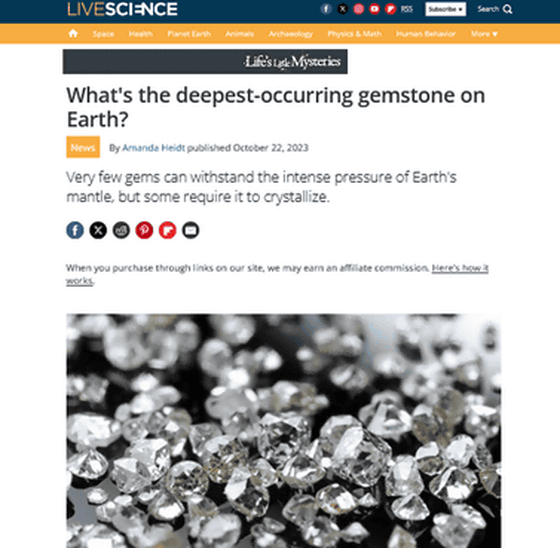What gemstones form in the deepest parts of the Earth?

Most gemstones are found at depths of 5km to 40km underground, but some can be easily found in shallow soil, while others can only be found deeper underground. Live Science, a science media outlet, has compiled research into what gemstones are predicted to be found at the deepest depths.
What's the deepest-occurring gemstone on Earth? | Live Science

Diamonds are one of the best-known gemstones formed deep inside the Earth, because the formation of natural diamonds requires that a collection of carbon atoms be exposed to extremely high temperatures and pressures, and diamonds are created deep inside the Earth where the pressures are extremely high.
Some gemstones, such as diamonds, contain inclusions, which are liquids or other minerals inside. Inclusions are often thought of as a factor that reduces the value of gemstones, but because diamonds are formed at a fairly deep point in the Earth, some research is being done to gain new knowledge about the Earth's interior by examining inclusions.
What is the 'new fact deep inside the Earth' that was trapped inside the ultra-rare diamond? - GIGAZINE

Along with diamonds, peridot is one of the gemstones discovered at the deepest depths. Peridot is a gemstone that shines green due to the iron it contains, and is a crystallized mineral called olivine , which makes up most of the upper mantle, extending up to 410 km underground.

However,
Below is a photo of a diamond collected in a mine in Lesotho , South Africa, as shown in a 2021 paper. Traditionally, peridot was considered important as a mineral with the properties of a rock called serpentine, which is an important element in investigating deep underground. However, metal inclusions have been detected in this diamond at a depth of 360 to 750 km, and the researchers argue that, like peridot, this diamond can provide information about the deep underground.

Research has estimated that some of the diamonds found on the Earth's surface today are 3.5 billion years old. Diamonds formed underground are pulled out of rocks by the force of eruptions of special magma containing highly volatile kimberlite , and flow to the Earth's surface over a period of hours to months.
Lee Grote, a mineralogist at the University of British Columbia, said, 'It's been difficult to determine whether diamonds or peridots are deeper, but this series of studies by GIA has pretty much settled the debate. Diamonds, which form and are transported from depths inaccessible to humans, are important not only for their beauty and industrial uses, but also for the scientific data they contain.'
Ananya Malik, an experimental petrologist at the University of Arizona, similarly emphasized the rarity of diamonds, saying, 'Diamonds are a unique resource that allows researchers to understand the structure of the Earth's interior and the processes taking place there. By studying gemstones, we have discovered that the early Earth was not as tectonically active as it is today. Other analyses have revealed traces of carbon, indicating that the carbon cycle extends deep into the Earth's interior. In some cases, new minerals have also been discovered within diamonds. Diamonds are valuable in themselves because of their beauty, but in addition, their scientific importance makes them even more valuable.'
Related Posts:
in Science, Posted by log1e_dh






